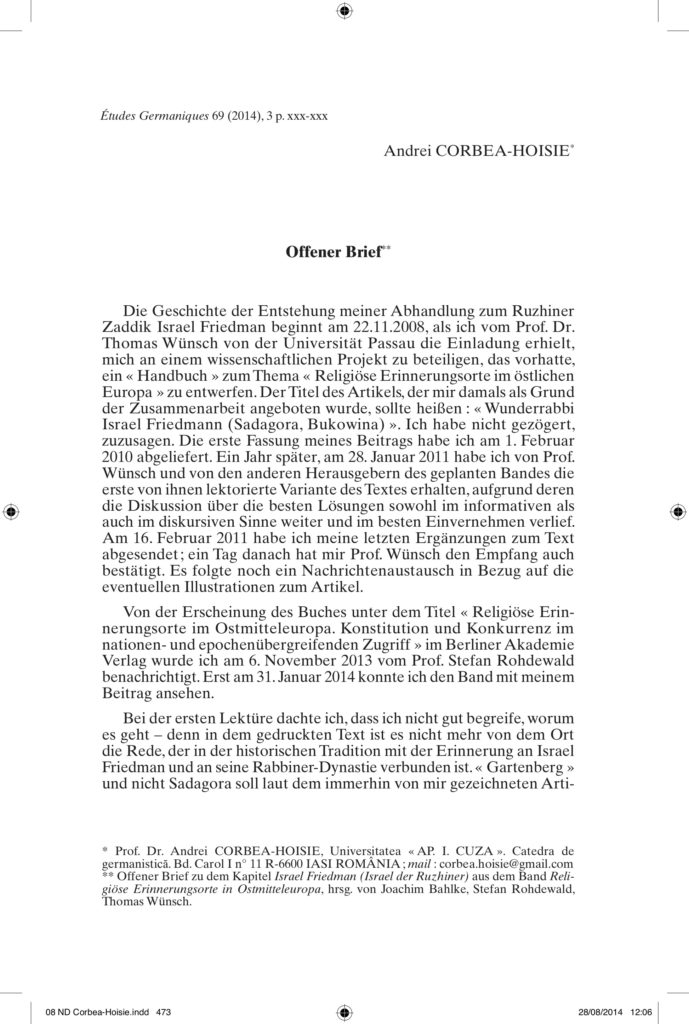Open Letter by Professor Andrei Corbea-Hoișie
Andrei Corbea-Hoișie is Professor of German Literature at the University of Iași, Romania. From 2005 to 2007 he served as Ambassador of Romania in Austria. He is a member of the Academy of Sciences of Erfurt. Corbea-Hoișie is a leading expert on multiculturalism in the historical landscape of Bukovina, and author of Czernowitzer Geschichten (2002) and La Bucovine: Éléments d’histoire politique et culturelle (2004). He has also published widely on Paul Celan and on the urban culture of Central Europe, and has translated writings of Theodor W. Adorno. In 2000 he received the Jacob and Wilhelm Grimm Award.
Chief Rabbi Noah Kofmansky • Z”L • May His Memory Be A Blessing
Religious Information Service of Ukraine: Chief Rabbi of Chernivtsi region dies. The chief rabbi of the Chernivtsi region, Noah Kofmansky died in Chernivtsi on May 20. This is reported by “Molodyy Bukovynets”. The farewell with the rabbi will be held on Tuesday, May 22, from 10 to 12 hours at the Jewish House on Teatralna Square, 5. Noah Kofmansky was born on September 13, 1946, in Chernivtsi to a deeply religious family. His grandfather was a rabbi. He received secular education at the universities of Moscow and Chernivtsi. He worked at large enterprises in Chernivtsi. In the late 70’s he traveled to Israel and received education in religious centers. Since 1995, he headed the Jewish religious community, was the chief rabbi of the Chernivtsi region. He was a lecturer at the Faculty of Theology at the National University, Sunday School at a synagogue, engaged in philanthropy, collaborated with Hesed and international Jewish charity organizations.





 Photos by courtesy of Adrzej Polec, Prof. Alti Rodal and Christel Wollmann-Fiedler!
Photos by courtesy of Adrzej Polec, Prof. Alti Rodal and Christel Wollmann-Fiedler!
Finding 1898 Czernowitz House Location

Plot No. 436 according to The Land Regsiter of Francis I vs. GoogleMaps
The Art and Writing of Arnold Daghani: Documenting a Neglected Aspect of the Holocaust
Grüße aus der Bukowina • Greetings from Bukovina
ca. 1921 envelope from Jordan Bernhard
Jordan is seeking background information about this envelope:

Czernowitz Art Album by Tetyana Dugaeva and Sergij Osatschuk
By the way and in the course of her research, the prominent art historian and former director of the Czernowitz Art Museum, Tetyana Dugaeva, showed up an art forgery which slipped in even into our Czernowitz Art Gallery. As a matter of fact, Berthold Klinghofer’s “Czernowitz. Ringplatz” from the year 1911 (at the top) found its counterpart in Victor Volkov’s copy (at the bottom). Excellent detective work!
Czernowitzer Deutsch
Original text by Emanuel Hacken, edited by Ruth Glasberg Gold
Dear Czernowitzians and all List members,
Ghetto List by ZRBG (German Social Security Ghetto Pension)
Holocaust survivors who voluntarily worked in a ghetto located in a territory occupied by or integrated into the German Reich may apply for two types of compensation payment: The Ghetto pension pursuant to ZRBG (German Social Security Ghetto Pension) and the Payment to victims of persecution in recognition of work in a ghetto. Please be aware that as of July 18, 2014, substantial changes to the Ghetto pension pursuant to ZRBG have been signed into law which are described below.
1. Ghetto pension pursuant to ZRBG (Law Regulating the Conditions for Pension Payments on the Basis of Employment in a Ghetto)
2. Payment to victims of persecution in recognition of work in a ghetto which did not constitute forced labor![]()
The articles “Ghetto: Financial Compensation for voluntary Labor in a Ghetto” by the German Missions in the United States and “German Social Security Ghetto Pension – ZRBG” by the Claims Conference provide additional information.
























